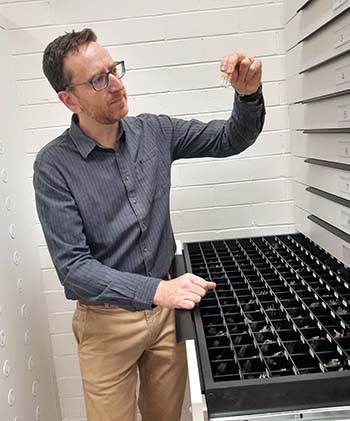A new GRDC investment will boost knowledge and understanding of rhizobia strains that are critical to the success of chickpea and mungbean rotations in cropping systems.
Legumes fix an estimated 3.5 million tonnes of nitrogen in Australian agriculture each year, equivalent to an annual fertiliser cost of $3.5 billion. This investment will focus on identifying strains with potential as superior inoculants for Group N (chickpea) and Group I (mungbean).
The GRDC-supported International Legume Inoculant Genebank (ILIG) at Murdoch University, led by Dr Jason Terpolilli, will spearhead efforts to characterise rhizobia strains in their collection.
In addition, the ILIG will continue expanding its collection by acquiring new, genetically diverse rhizobia germplasm from environments relevant to pulses grown in Australia.
 International Legume Inoculant Genebank (ILIG) lead Dr Jason Terpolilli says GRDC investment will support characterisation and development of superior rhizobia strains for Australian pulse growers. Photo: Supplied, ILIG, Murdoch University.
International Legume Inoculant Genebank (ILIG) lead Dr Jason Terpolilli says GRDC investment will support characterisation and development of superior rhizobia strains for Australian pulse growers. Photo: Supplied, ILIG, Murdoch University.
Dr Terpolilli said a key focus of the project will be the genetic sequencing of key rhizobia strains and development of a field test to identify the specific rhizobia responsible for nodulating chickpea or mungbean crops.
“Some rhizobia are quicker to partner with host legumes than others, but they can also be less efficient at fixing nitrogen after nodulation,” Dr Terpolilli said.
“In some cases, these strains can outcompete the desired inoculant strains in the soil, reducing the overall effectiveness of the inoculation.
“Genetic sequencing will help us develop field tests to ensure effective inoculation by the desired rhizobia strain. It will also support the identification of genetic markers to select new strains that fix greater rates of nitrogen and are better adapted to Australian soil conditions.”
GRDC genetic technologies investment manager Dr Camilla Hill says the investment will help ensure Australian pulse growers have access to more effective rhizobial inoculants, along with testing to ensure their crops have been nodulated by those premium rhizobia strains.
“Rhizobia have a unique ability to fix atmospheric nitrogen directly from air moving through the soil and convert it into a form that is accessible to crops,” she says.
“In symbiosis with legumes, rhizobia can add an average of 30 kilograms of nitrogen per hectare of soil – and up to 60 kg/ha – for use by following cereal crops.
 GRDC genetic technologies investment manager Dr Camilla Hill says the investment will help ensure Australian pulse growers have access to more effective rhizobial inoculants. Image: Evan Collis/GRDC
GRDC genetic technologies investment manager Dr Camilla Hill says the investment will help ensure Australian pulse growers have access to more effective rhizobial inoculants. Image: Evan Collis/GRDC
“That has the potential to save growers millions of dollars in fertiliser costs every season with the added benefit of a valuable pulse harvest.”
It is anticipated that growers will have access to superior rhizobia inoculants through the outputs of this project.
The new investment will also support the ILIG in implementing advanced strain preservation techniques to enhance quality assurance and control, streamline core operations, and increase efficiency.
Core ILIG strains will undergo genome sequencing, providing genotypic data for the 90 per cent of strains collected before the advent of genomic technologies.
This updated genotypic data will be incorporated into an enhanced public online database, accessible to stakeholders.
Additionally, the ILIG will continue to acquire new and genetically diverse rhizobia germplasm from environments relevant to pulse crops grown in Australia, further expanding its collection.
ILIG was established with GRDC support in 2020 to consolidate the various rhizobia collections that had been independently established by different organisations across Australia since the 1950s. Today, it stands as the largest and most diverse rhizobia collection in the world. ILIG staff continue to expand this collection, both domestically and internationally, with a focus on rhizobia strains that exhibit beneficial traits, such as improved nodulation of newer legume varieties, enhanced nitrogen fixation, and greater tolerance to hot and dry soil conditions.

























































